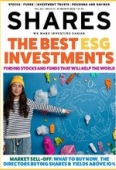Archived article
Please note that tax, investment, pension and ISA rules can change and the information and any views contained in this article may now be inaccurate.
How Pictet’s ESG fund searches for experts saving the environment

There are a large number of investment funds ready to cater for investors’ growing appetite for all things ESG. To get noticed funds have to distinguish themselves from the crowd by having something very clever about how they pick assets and manage portfolios.
Among the larger funds in the market is Pictet Global Environmental Opportunities (B4YWL06) with €1.7bn of assets under management. Co-fund manager Luciano Diana says a scientific approach, considerable in-house expertise and an advisory board differentiate the fund from others.
Pictet is a big name in the world of thematic investing with a range of funds that aim to capitalise on megatrends, encompassing how changes in technology, the environment and society will shape the world.
In particular, growing awareness about the need to tackle climate change by individuals, companies and governments has helped to fuel a thriving industry for environmental products and services.
Pictet Global Environmental Opportunities invests in environmental solution providers such as waste management companies, recycled packaging experts and pollution control specialists.
HOW IS THE FUND DIFFERENT?
While you might think it is fairly straightforward to find stocks active in these areas, Pictet argues its research goes much deeper.
Key to its screening process is the use of the planetary boundaries framework which identifies nine areas critical to the planet. It focuses on these dimensions:
• climate change
• biodiversity loss and extinction
• freshwater use
• ocean acidification
• ozone depletion
• land system change
• aerosol loading
• chemical pollution
• nitrogen and phosphorus flows to the biosphere
and ocean
‘Each one has a threshold and if exceeded we risk changing the environment with no way back once you hit the tipping point,’ says Diana.
Companies will only be considered for the portfolio if they operate in a safe place within the planetary boundaries.
You won’t see Pictet back any companies involved in over-consumption of natural resources which means no oil, gas, mining or heavy industry in the portfolio.
It looks for companies providing solutions and assesses their propositions including any technology. ‘For example, industrial agriculture often over-uses agricultural nutrients which end up in rivers. This results in algae bloom and ocean dead zones which hurt marine life. We look for solutions that are alternatives to agri-nutrients,’ says Diana.
INVESTABLE UNIVERSE
The Pictet fund’s rigorous process means only 400 companies qualify for investment consideration; of these, only about 50 are held in the portfolio.
Diana says environmental solution providers fall into seven categories:
• renewable energy
• energy efficiency
• sustainable agriculture
and forestry
• water supply and technologies
• waste management and recycling
• pollution control
• dematerialised economy
The fund’s biggest holdings are Autodesk and Ansys which both specialise in 3D design and engineering. You might think they are odd stocks for an environmental fund yet it is precisely the type of company that ticks all the boxes for Pictet.
The companies fall under the category of a dematerialised economy. By creating simulations of buildings they are helping construction and engineering firms to have less need for physical prototypes, thus reducing raw material consumption.
Companies with tools for environmental testing, such as air, water, soil and food quality measurement, also feature prominently in the fund’s portfolio. Relevant holdings include chemical analysis expert Agilent, instrumentation provider Thermo Fisher Scientific and a pair of testing groups, SGS and Intertek (ITRK).
For the pollution control theme it holds Tetra Tech because of strengths in its US environmental and engineering business. Orsted is held to play the renewable energy theme, with Diana noting a competitive advantage in offshore wind. And for sustainable agriculture the fund invests in Symrise which has a focus on sustainability and natural ingredients for the food market.
MULTIPLE STOCKS FOR SAME THEME
The fact it owns multiple companies in the same space is interesting given that it has a fairly concentrated portfolio. One might assume it would only hold its strongest idea.
In addition to the pairs of Autodesk/Ansys and SGS/Intertek, in the packaging arena it holds both Smurfit Kappa (SKG) and Mondi (MNDI), and in the waste management space it invests in three stocks with similarities: Republic Services, Waste Connections and Waste Management Inc.
‘If we have two or three stocks in the same area in the portfolio, so be it,’ says Diana. ‘Their presence is about us having conviction. We have 3% each in three waste management firms, for example, but our process wouldn’t lead us to have 9% of the portfolio in just one of those companies.’
PERFORMANCE TRACK RECORD
The fund launched in July 2011 and it took a year before the performance really started to pick up. Since inception it has achieved a total return of 117.6% (as of 11 March 2020).
On a one, three and five year basis the fund has outperformed its MSCI World index benchmark by a decent amount (see table) and has been in the top quartile for performance. In the recent market sell-off it has fallen by less than the benchmark (-6.4% versus -8.6% respectively over three months).
We like this fund’s investment approach and believe it provides a good way of playing the ESG theme. Pictet is very clear about what it wants in the portfolio and you’re not simply getting a basket of stocks with random environmental connections which is sadly the case with many other ESG funds. We rate it as one of the top ESG investments to own.
DISCLAIMER
The author has a personal investment in this fund.
Important information:
These articles are provided by Shares magazine which is published by AJ Bell Media, a part of AJ Bell. Shares is not written by AJ Bell.
Shares is provided for your general information and use and is not a personal recommendation to invest. It is not intended to be relied upon by you in making or not making any investment decisions. The investments referred to in these articles will not be suitable for all investors. If in doubt please seek appropriate independent financial advice.
Investors acting on the information in these articles do so at their own risk and AJ Bell Media and its staff do not accept liability for losses suffered by investors as a result of their investment decisions.

 magazine
magazine










